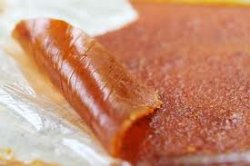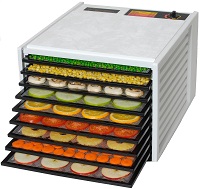Anyone can do this!
Dehydrating your own foods can be a more nutritious and less expensive method of preserving fruits, vegetables, and meats.There are several methods of dehydrating your own foods:
- Electric dehydrators
- Commercially made non-electric dehydrators
- Mother Nature's sun and wind
The more natural methods are less expensive (or the sun and wind are free) but do take much more time for the drying process, not to mention trying to keep the bugs off the food and making sure the food is 99.9% moisture-free. For storage purposes, the moisture content must be as low as possible.
Dehydrating With Excalibur
It couldn't be easier! Seriously! You know how much space canned and bottled food takes up. And how about your freezer? Is it big enough to hold all the vegetables or fruits you might grow in your garden? And if the electricity goes out for an extended time? Big problem. Well, we all know the freezer is not for long-term food storage.Dehydrated and freeze-dried foods bought from a retail store are great to have in your survival supplies, but they are expensive. One season of drying your own fruits and vegetables or making your own jerky would pay for an Excalibur dehydrator — even the most expensive one! And they do come in 4, 5, and 9 tray versions. (See side column.)
What can you use your Excalibur for? (Let us count the ways!)
- All fruits and vegetables (yes, even oranges which are quite juicy)
- Make beef, elk, deer, chicken, pork jerky. (Try all kinds of seasonings.)
- Dehydrate salmon, trout, talapia, shrimp - any fish!
- Dry your home-grown spouts for the ultimate nutritious veggies!
- Make your own yogurt.
- Use it to let your home-made bread rise.
- Dry flowers and other plants for crafts.
Store tons of food in very little space.
Properly packaged, the shelf life can be up to 25 years — just like store bought. But the difference? No preservatives. No high salt content. No fillers.Best of all? Saves you lots of money! So . . . find the size Excalibur that fits your needs.
Dehydrating With Mother Nature
When my children were young, fruit leather (or fruit roll-ups) was the "sweet" of the day, with apricots being the first choice of fruit.Homemade Fruit Leather

- Wash the fruit, cut in half, toss the pit away.
- Throw the fruit into a blender, and add sugar to taste (or not). Add a little lemon juice to keep the leather from going dark as it dries.
- Cover a cookie sheet with plastic wrap and pour on the pureed fruit. If it reaches the edges of the cookie sheet, stop pouring or it will be too thick. Get another cookie sheet for the rest.
- Cover the cookie sheet with cheese cloth to keep the flies out, using wooden spring-type clothes pins (or other type of clasp) to hold it taut so it doesn't touch the fruit puree. Put it out in the sun. If the wind is blowing, the time will be decreased.
Drying Vegetables
- Green beans can be strung by using a needle and strong thread. Tie a knot in one end and push the needle through the center of the beans, Pushing the beans towards the know. When you get 2 or 3 feet of beans on the string, hang the beans up by the end in a warm dry area, but out of direct sunlight. Let them hang until the beans are dry. Store in a paper or cloth bag until ready for use.
- Peas can be laid in the sun to dry. After they are dry, wait for a windy day. Place them on a sheet and beat the hulls off with a stick. The wind will blow the chaff away and leave just the peas. Store the peas in a paper or cloth bag until use.
- Corn - cut the corn off the cob and lay in the sun until dry.
- Tomatoes (I know, they're really a fruit) - Slice very thin and season with anything that sounds good to you - experiment. Lay out on cookie sheets covered with cheese cloth. They almost taste like a candy treat when dried!
Sanitation is Key
Most fruits and vegetables can be dried without any special instructions if you just use common sense. That means good sanitation practices.- Don't dry any produce that is badly bruised or has any rot.
- Keep the food clean and protect it from insects during the drying process.
- Window screens can be used to make a box allowing airflow but protecting the fruits and vegetables from flies, etc.
- Put into #10 cans or glass bottles with oxygen absorbers; or
- Vacuum seal
in appropriate bags.

No comments:
Post a Comment
Do To the enormous amounts of spam I will no longer take the time to moderate Anyone posting under anonymous... Sorry for the inconvenience but my email is blasted everyday with 40 to 50 anonymous posts that are junk mail. I just don't have the time to read each one before deleting.